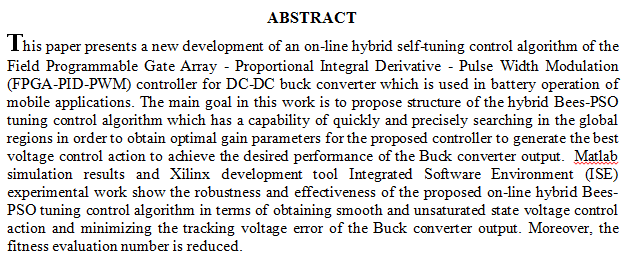
A specific, sensitive and new simple method was used for the determination of methyldopa in pure and pharmaceutical formulations by using continuous flow injection analysis. This method is based on formation of ion pair compound between methyldopa and potassium hexacyanoferrate in acidic medium to obtain a yellow precipitate complex using long distance chasing photometer (NAG-ADF-300-2). The linear range for calibration graph was 0.05-35 mmol/L for cell A and 0.05-25 mmol/L for cell B, and LOD 1.4292 µg /200 µL for both cells with correlation coefficient (r) 0.9981 for cell A and 0.9994 for cell B, RSD% was lower than 0.5 % for n=8 for. The results were compared with classical method UV-Spectrophotometric at λ max=280 nm and turbi
... Show More (1)
(1)
 (2)
(2)
New chalcones of -{ - - - y - - hi di z e- -y he y - - e e- - e- - - substituted phenyl have been prepared from condensation of a new of 4-[5-(4`-tolyl)1,3,4-thiadiazole-2-yl] benzaldehyde (which is synthesized by the reaction of 2- amino-5- (4`-tolyl) -1,3,4-thiadiazole and benzaldehyde) with 3- or 4- substituted acetophenones in alkaline medium. The physical, CHNS analysis and spectral data of the synthesized compounds were determined. The biological activity evaluated of new compounds showed that many of these compounds possess antiba
... Show More (5)
(5)
The study involved preparing a new compound by combining Schiff bases generated from compounds for antipyrine, including lanthanide ions (lanthanum, neodymium, erbium, gadolinium, and dysprosium). The preparation of the ligand from condensation reactions (4-antipyrinecarboxaldehyde with ethylene di-amine) at room temperature, and was characterization using spectroscopic and analytical studies ( FT-IR, UV-visible spectra, 1H-NMR, mass spectrometry, (C.H.N.O), thermogravimetric analysis (TGA), in addition to the magnetic susceptibility and conductivity measurement of the synthesis complexes, among the results we obtained from the tests, we showed that the ligand behaves with the (triple Valence) lanthanide ions, the multidentate
... Show More (7)
(7)
 (2)
(2)
Activated carbon prepared from date stones by chemical activation with ferric chloride (FAC) was used an adsorbent to remove phenolic compounds such as phenol (Ph) and p-nitro phenol (PNPh) from aqueous solutions. The influence of process variables represented by solution pH value (2-12), adsorbent to adsorbate weight ratio (0.2-1.8), and contact time (30-150 min) on removal percentage and adsorbed amount of Ph and PNPh onto FAC was studied. For PNPh adsorption,( 97.43 %) maximum removal percentage and (48.71 mg/g) adsorbed amount was achieved at (5) solution pH,( 1) adsorbent to adsorbate weight ratio, and (90 min) contact time. While for Ph adsorption, at (4) solution pH, (1.4) absorbent to adsorbate weight ratio, and (120 min) contact
... Show More (3)
(3)
A multistep synthesis was established for the preparation of a new vanillic acid-1, 2, 4-1triazole-3-thiol conjugate (
 (1)
(1)
 (1)
(1)
Background: Suppression of quorum sensing (QS) that regulates many virulence factors, including antimicrobial resistance, in bacteria may subject the pathogenic microbes to the harmful consequences of the antibiotics, increasing their susceptibility to such drugs. Aim: The current study aimed to make an aqueous crude extract from the soil Proteus mirabilis isolate with the use of the gas chromatography-mass spectrometry (GC-MS) technique for its analysis, and then, study the impact of the extract on clinical isolates of Pseudomonas aeruginosa. Methods: Preparation of crude extracts from P. mirabilis (both organic and aqueous), which were then analyzed by GC-MS to detect the bioactive ingredients. Furthermore, the extract’s capability to i
... Show MoreCombining different treatment strategies successively or simultaneously has become recommended to achieve high purification standards for the treated discharged water. The current work focused on combining electrocoagulation, ion-exchange, and ultrasonication treatment approaches for the simultaneous removal of copper, nickel, and zinc ions from water. The removal of the three studied ions was significantly enhanced by increasing the power density (4–10 mA/cm2) and NaCl salt concentration (0.5–1.5 g/L) at a natural solution pH. The simultaneous removal of these metal ions at 4 mA/cm2 and 1 g NaCl/L was highly improved by introducing 1 g/L of mordenite zeolite as an ion-exchanger. A remarkable removal of heavy metals was reported
... Show MoreThis investigation reports application of a mesoporous nanomaterial based on dicationic ionic liquid bonded to amorphous silica, namely nano-N,N,N′,N′-tetramethyl-N-(silican-propyl)-N′-sulfo-ethane-1,2-diaminium chloride (nano-[TSPSED][Cl]2), as an extremely effectual and recoverable catalyst for the generation of bis(pyrazolyl)methanes and pyrazolopyranopyrimidines in solvent-free conditions. In both synthetic protocols, the performance of this catalyst was very useful and general and presented attractive features including short reaction times with high yields, reasonable turnover frequency and turnover number values, easy workup, high performance under mild conditions, recoverability and reusability in 5 consecutive runs without lo
... Show MoreCadmium oxide CdO thin films were prepared by successive ionic layer adsorption and reaction (SILAR) technique at varying number of dippings. The CdO thin films were prepared from a source material of Cadmium acetate and ammonium hydroxide solution deposited on glass substrate at 95℃. The prepared thin films were investigated by X-ray diffraction (XRD), Atomic force microscopy (AFM), Scanning Electron Microscopy (SEM), Fourier Transform Infrared (FTIR), and UV-Visible spectrometry. The XRD analysis reveals that the films were polycrystalline with cubic structure having preferential orientation along (1 1 1), (2 0 0), (2 2 0), and (3 1 1) planes. While the tests of the scanning electron microscopy and the atomic force mic
... Show MoreThe biological activities of some ternary nickel complexes with a Schiff base obtained from 4-dimethylaminobenzaldehyde and 2-aminophenol have been reported. The Schiff base ( HL1) acts as a primary ligand whereas, anthranilic acid ( HL2), 2-nitroaniline ( HL3), alanine ( HL4) and histidine ( HL5) act as secondary ligand or co-ligand. The anticancer activity of these compounds was studied against human colon carcinoma (HCT-116), human hepatocellular liver carcinoma (HEPG-2) and human breast carcinoma (MCF-7) cell lines. As per the results, the compounds were active against the cell lines. The antioxidant activity of the same compounds was evaluated using DPPH (1,1-diphenyl-2-picryl-hydrazyl) radical scavenging and compared with ascorbic aci
... Show More